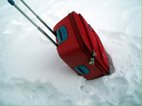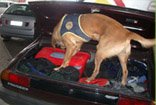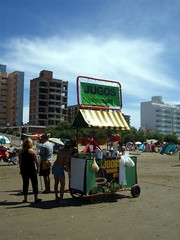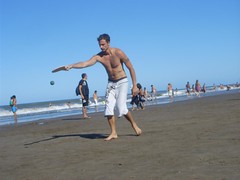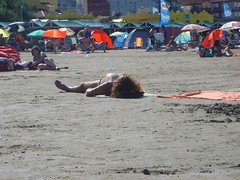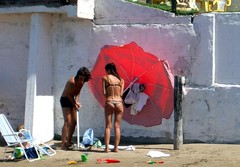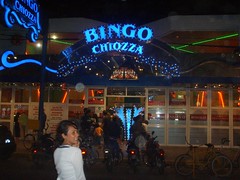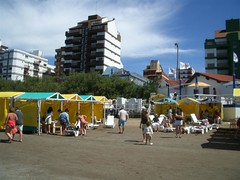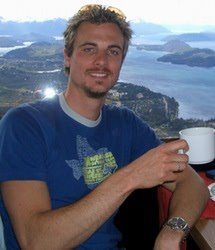87. Back in BA (Buenos Aires, Argentina)
Our last day in San Bernardo, a Sunday, was an eye opener, as it was the last day of the high season and thus the first day of the low season. Opening hours of the shops were cut back to normal, many businesses had already been moth-balled and boarded up, and almost all the apartments around town had the shutters down, deserted by their owners or tenants until next summer. It already started to feel like a ghost town.
We're now back in BA, and the van has been given to a car dealer to be sold on my behalf, for which he'll take around 4% commision. I'd wanted to sell the van in Bariloche so as to have it off my hands once and for all. But my girlfriend was reluctant to ship all her cosas (belongings) by bus, so we'd decided to drive to BA for their sake. It wasn't a bad idea, as we could sleep in the van along the way and also give rides to Hamish and family and Mark. But sure enough, the van crapped out more than once along the way - overdue repairs I'd neglected to do finally caught up with me.
BA in March is still hot and humid, but bearable - although the nights can get uncomfortably sticky. I know I'm in BA since my slight asthma, which was dormant in Bariloche, has returned.
We got a room in our same pension hotel in San Telmo for $450 pesos per month. The same room went for $300 pesos when I first arrived here 2 years ago - inflation. I've noticed a lot of things have gone up in price since I last visited BA in November - internet cafe's especially. Last year most of the places around San Telmo were $1.50 pesos an hour but now they're all around $2. However, BA has become the 2nd city in the world to have WiFi in ALL its subway stations. That's pretty cool, and something to be proud of, but there's some problems:
Anyway, so now we wait. Waiting for the van to sell, and waiting for Aerolineas Argentinas' flights to NZ to drop in price, around the end of the month. I know I moaned about Aerolineas before, but their baggage allowance to NZ is 2 x 32kg whereas LAN Chile's is 2 x 23kg - and I'm gonna need that extra weight to get all my cosas home. But it's a bit disconcerting to learn that neither of Buenos Aires' airports have functioning radar at the moment! Apparently incoming and outgoing flights have to report their velocity and position by radio - "it's back to the 60s" said one pilot.
We're now back in BA, and the van has been given to a car dealer to be sold on my behalf, for which he'll take around 4% commision. I'd wanted to sell the van in Bariloche so as to have it off my hands once and for all. But my girlfriend was reluctant to ship all her cosas (belongings) by bus, so we'd decided to drive to BA for their sake. It wasn't a bad idea, as we could sleep in the van along the way and also give rides to Hamish and family and Mark. But sure enough, the van crapped out more than once along the way - overdue repairs I'd neglected to do finally caught up with me.
BA in March is still hot and humid, but bearable - although the nights can get uncomfortably sticky. I know I'm in BA since my slight asthma, which was dormant in Bariloche, has returned.
We got a room in our same pension hotel in San Telmo for $450 pesos per month. The same room went for $300 pesos when I first arrived here 2 years ago - inflation. I've noticed a lot of things have gone up in price since I last visited BA in November - internet cafe's especially. Last year most of the places around San Telmo were $1.50 pesos an hour but now they're all around $2. However, BA has become the 2nd city in the world to have WiFi in ALL its subway stations. That's pretty cool, and something to be proud of, but there's some problems:
- Lack of security in the stations makes pulling out a laptop a risky proposal.
- It's in all the stations but on none of the trains, so you can't use it while you're commuting. And since there's a train every 5 minutes or so you never spend much time waiting in a station.
- There's not much seating available in the stations, and you need to sit to pull out your laptop.
Anyway, so now we wait. Waiting for the van to sell, and waiting for Aerolineas Argentinas' flights to NZ to drop in price, around the end of the month. I know I moaned about Aerolineas before, but their baggage allowance to NZ is 2 x 32kg whereas LAN Chile's is 2 x 23kg - and I'm gonna need that extra weight to get all my cosas home. But it's a bit disconcerting to learn that neither of Buenos Aires' airports have functioning radar at the moment! Apparently incoming and outgoing flights have to report their velocity and position by radio - "it's back to the 60s" said one pilot.
